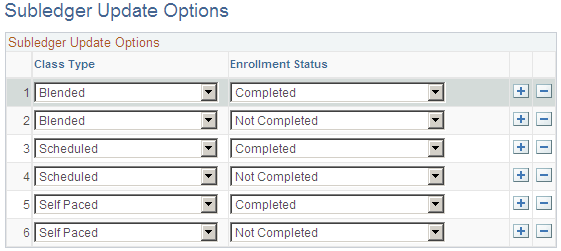Setting Up Subledgers
To set up subledgers use the Subledger Setup component (LM_SUBLEDGER_ID) and the Subledger Update Options component (LM_SUBLEDGER_UPD).
|
Page Name |
Definition Name |
Usage |
|---|---|---|
|
LM_SUBLEDGER_ID |
Create subledger groups. |
|
|
LM_SUBLEDGER_UPD |
Associate class types with class enrollment statuses. The combination of these values determines when transactions for class fees are ready to be written to the subledger. |
Enterprise Learning Management uses subledgers to store the transaction data that you eventually export to the general ledger in the financials system. To set up subledgers you must:
Create subledger groups.
You can create as many subledger groups as necessary. For example, you can create a subledger group for each month or each quarter of the year. Determine the subledger groups that you must create based on the business needs of the organization.
Define rules for updating the subledger groups.
You must specify criteria for when a transaction is ready to be written to a subledger group. This criteria is based on the class type and the learner's enrollment status. You can post transactions for classes that meet the specified criteria to a subledger group. Chargeback transactions in the subledger groups are eventually exported and written to the general ledger in the financials system. Revenue transactions are not exported to an accounts receivable system. However, you can create a process to export revenue transactions to the accounts receivable system if necessary.
Use the Subledger page (LM_SUBLEDGER_ID) to create subledger groups.
Navigation:
This example illustrates the fields and controls on the Subledger page.

Field or Control |
Description |
|---|---|
Subledger |
Enter a subledger group ID. |
Description |
Enter a description of the subledger group. |
Delete Subledger Group |
Click to delete a subledger group. This button is available only for subledger groups that do not contain transactions. This prevents you from deleting a subledger group that contains transactions. |
Use the Subledger Update Options page (LM_SUBLEDGER_UPD) to associate class types with class enrollment statuses.
The combination of these values determines when transactions for class fees are ready to be written to the subledger.
Navigation:
This example illustrates the fields and controls on the Subledger Update Options page.

Field or Control |
Description |
|---|---|
Class Type |
Select a class type. Values are: Blended: a class that contains both scheduled and self-paced learning component types. Scheduled: a class that contains only scheduled learning component types. Self-paced: a class that contains only self-paced learning component types. |
Enrollment Status |
Select an enrollment status: Completed, Denied, Dropped, Enrolled, In-Progress, Learning Request, Moved to New Class, Not Completed, Payment Approval, Pending Approval, Pending Payment, Planned, Waitlisted, or Waived. You can specify as many enrollment statuses as you need for each class type. It's important to consider which combinations will work best for the business needs. You should also follow Generally Accepted Accounting Principles (GAAP) for any external transactions. |